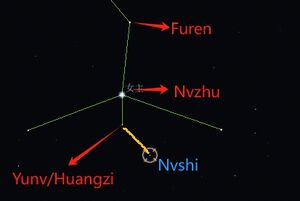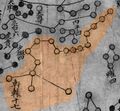Xuanyuan: Difference between revisions
Boshunyang (talk | contribs) No edit summary |
Boshunyang (talk | contribs) |
||
| Line 4: | Line 4: | ||
The Yellow Emperor is a legendary figure in China. It is unknown whether or not the "persona" goes back to a real ruler of the country in the 3rd millennium or is completely invented. In the 20th century, this figure was made a symbol for the creator of the state of China and bringer of civilization. |
The Yellow Emperor is a legendary figure in China. It is unknown whether or not the "persona" goes back to a real ruler of the country in the 3rd millennium or is completely invented. In the 20th century, this figure was made a symbol for the creator of the state of China and bringer of civilization. |
||
In astrology, it mainly represents the concubines of the Yellow Emperor's harem. Based on the brightness and position of these stars, ancient astrologers named them after different ranks of concubines, mong which the most important is the Nvzhu, representing the emperor's primary wife (the queen), |
In astrology, it mainly represents the concubines of the Yellow Emperor's harem. Based on the brightness and position of these stars, ancient astrologers named them after different ranks of concubines, mong which the most important is the Nvzhu, representing the emperor's primary wife (the queen), alf Leo. In terms of form, this star also represents the head of the Yellow Dragon, while the stars on the left and right represent its horns (rho, Omicron). |
||
[http://www.ianridpath.com/startales/leo.html Ian Ridpath's webpage on Leo] has more information. |
[http://www.ianridpath.com/startales/leo.html Ian Ridpath's webpage on Leo] has more information. |
||
| Line 11: | Line 11: | ||
As one of the oldest Chinese constellations, Xuanyuan is depicted on many historical star charts from China. |
As one of the oldest Chinese constellations, Xuanyuan is depicted on many historical star charts from China. |
||
=== Lost |
=== Lost ones === |
||
A weishu book from the western Han Dynasty (1stcentury BCE), titled ''Xiao Jing · Yuan Shen Qi (孝经·援神契),'' mentions a kind of Xuanyuan constellation with only 12 stars, compared to the current one with 17 stars. It is possible because the current Xuanyuan constellation includes several very faint stars. Since star maps from that time no longer exist, we cannot determine the specific configuration of these twelve stars. However, according to records, we know that it at least included the prominent/determinative star Nvzhu(Queen, |
A weishu book from the western Han Dynasty (1stcentury BCE), titled ''Xiao Jing · Yuan Shen Qi (孝经·援神契),'' mentions a kind of Xuanyuan constellation with only 12 stars, compared to the current one with 17 stars. It is possible because the current Xuanyuan constellation includes several very faint stars. Since star maps from that time no longer exist, we cannot determine the specific configuration of these twelve stars. However, according to records, we know that it at least included the prominent/determinative star Nvzhu(Queen, alf Leo), Furen (higher concubine, eta Leo) and Yunv (lower concubine, 31 Leo).<ref>Yasui Kōzan 安居香山,Nakamura Shōhachi 中村璋八,''Weishu jicheng'' 纬书集成. Hebei Renmin Chubanshe河北人民出版社,1994,p958.</ref> This early variant of Xuanyuan should be consistent with the 17-star form regarding the stars in the southern region. |
||
[[File:The Location of Nvshi in Xuanyuan.jpg|thumb|The Location of Nvshi in Xuanyuan]] |
|||
''The Huangdi(Yellow emperor)'s Divination'' is a book that possibly originated during the Han Dynasty. It records a kind of Xuanyuan constellation with also 17 stars, but in its account, Xuanyuan consists of another small star called Nvshi (Female historian, pi Leo) at the south of the Yunv star with a distance of 2 degrees. |
|||
=== Identification of stars === |
=== Identification of stars === |
||
Revision as of 04:06, 20 April 2024
Xuanyuan is the name of the Yellow Emperor. But in Chinese astrology, it is a constellation/ asterism symbolizes the body of a yellow dragon. It consists of 17 stars in the area of Leo and Lynx.
Etymology & History of the term
The Yellow Emperor is a legendary figure in China. It is unknown whether or not the "persona" goes back to a real ruler of the country in the 3rd millennium or is completely invented. In the 20th century, this figure was made a symbol for the creator of the state of China and bringer of civilization.
In astrology, it mainly represents the concubines of the Yellow Emperor's harem. Based on the brightness and position of these stars, ancient astrologers named them after different ranks of concubines, mong which the most important is the Nvzhu, representing the emperor's primary wife (the queen), alf Leo. In terms of form, this star also represents the head of the Yellow Dragon, while the stars on the left and right represent its horns (rho, Omicron).
Ian Ridpath's webpage on Leo has more information.
Historical Maps
As one of the oldest Chinese constellations, Xuanyuan is depicted on many historical star charts from China.
Lost ones
A weishu book from the western Han Dynasty (1stcentury BCE), titled Xiao Jing · Yuan Shen Qi (孝经·援神契), mentions a kind of Xuanyuan constellation with only 12 stars, compared to the current one with 17 stars. It is possible because the current Xuanyuan constellation includes several very faint stars. Since star maps from that time no longer exist, we cannot determine the specific configuration of these twelve stars. However, according to records, we know that it at least included the prominent/determinative star Nvzhu(Queen, alf Leo), Furen (higher concubine, eta Leo) and Yunv (lower concubine, 31 Leo).[1] This early variant of Xuanyuan should be consistent with the 17-star form regarding the stars in the southern region.
The Huangdi(Yellow emperor)'s Divination is a book that possibly originated during the Han Dynasty. It records a kind of Xuanyuan constellation with also 17 stars, but in its account, Xuanyuan consists of another small star called Nvshi (Female historian, pi Leo) at the south of the Yunv star with a distance of 2 degrees.
Identification of stars
| Rufus and Tien (1945)
Suzhou map |
HO (1962) | SUN Shuwei
Su Song map |
SUN X. & J. Kistemaker
Han Dynasty |
Boshun Yang | |
|---|---|---|---|---|---|
| determinative star of X. | alf Leo | alf Leo | alf Leo | alf Leo | alf Leo |
| 4th star of X. | alf Lyn | ||||
| Cifei | alf Lyn |
Preserved Images
constellation Xuanyuan on the Suzhou Star Chart (retrieved from https://www.chinesehsc.org/zoomify/suzhou_planisphere.html)
Star Name Discussion (IAU)
Europeans in the IAU WGSN proposed in 2023/4 to use the name "Xuanyuan" for any star in this area, for instance, apply it to the star "alf Lyn" in the IAU-Catalog of Star Names (CSN).
The Chinese members of IAU WGSN considered "Xuanyuan" too important in Chinese Culture and refused to apply this name to any other than the determinative star. Hence, the only proper star for this name would be alpha Leonis which is already named "Regulus". Therefore, the IAU WGSN decided to not use "Xuanyuan" as a name of any stars.
- ↑ Yasui Kōzan 安居香山,Nakamura Shōhachi 中村璋八,Weishu jicheng 纬书集成. Hebei Renmin Chubanshe河北人民出版社,1994,p958.








